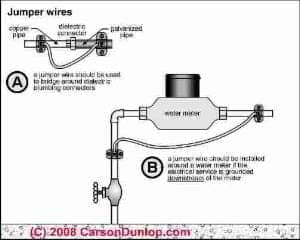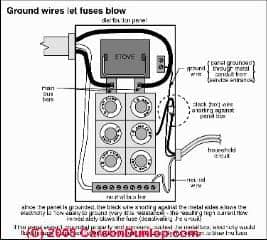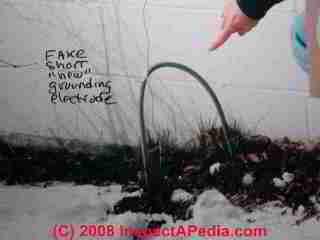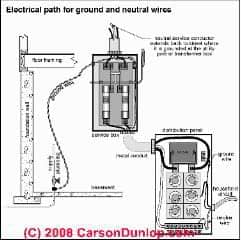 Electrical System Grounds, Ground Wiring, Grounding Conductors, Grounding Electrodes
Electrical System Grounds, Ground Wiring, Grounding Conductors, Grounding Electrodes
Why electrical grounding is required
- POST a QUESTION or COMMENT about the requirement for electrical grounding & electrical ground system definitions
Need & requirements for electrical grounding systems: this document discusses the details of why we need grounding, and definitions of electrical grounding and electrical bonding (what's the difference between these two terms.
InspectAPedia tolerates no conflicts of interest. We have no relationship with advertisers, products, or services discussed at this website.
- Daniel Friedman, Publisher/Editor/Author - See WHO ARE WE?
Why Do We Need Electrical Grounding, Ground Rods, Earthing, Bonding in Electrical Wiring Systems?

“Grounding”, article 250 in the NEC, is probably one of the most difficult of the often used articles. In 2005 article 250 became “Grounding and bonding”.
In the 2008 NEC there has been a major revision in language, and phrases like “shall be grounded” have changed to “shall be connected to an equipment grounding conductor.” - Sketch courtesy of Carson Dunlop Associates, a Toronto home inspection, education & report writing tool company [ carsondunlop.com ].
Here we define electrical ground, grounding, bonding, and earthing terms and explain why there are important differences among these words.
Sketch courtesy of Carson Dunlop Associates, a Toronto home inspection, education & report writing tool company [ carsondunlop.com ].
See DEFINITIONS of Electrical Ground, Grounding Electrode, Grounding Conductor, Grounded Conductor, Ground Wire, Neutral Wire, Ground Rod, for definitions of these confusing electrical terms.
Why we need electrical grounding
Speaking first a bit loosely (we'll get careful and detailed in a minute) the grounding system at a building provides an easy path for electricity to flow to earth should certain problems occur (a power surge, lightning strike).
Bonding or connection in the electrical panel between the neutral wires, ground wires, and the utility company's incoming neutral wire allowing current to flow to the utility company's wiring, assuring that a circuit breaker will trip or fuse will blow should a problem occur such as a short circuit or overloaded circuit.
Properly operating these overcurrent devices help prevent fire and shock.
Should an electrical fault occur where no neutral connection to the utility company or no local ground path is present, the electrical potential is just sitting there waiting for a person to come along, touch some component of the system, and by accidentally providing a path to earth through their body, receive a burn or potentially fatal shock.
Details of why we need grounding, and definitions of electrical grounding and electrical bonding (what's the difference between these two terms) can be read at Why Grounding is Needed.
 Bud, a master electrician from Minnesota has offered these important clarifications:
Bud, a master electrician from Minnesota has offered these important clarifications:
"Grounding" has 2 main functions.
One is to provide a path to trip a breaker in the event of a 'short' as in the text above. That function relies on a "ground"-to-neutral connection required at services in the US (the "main bonding jumper"). The path is (branch circuit ground wire) to (N-G bond at the service) to (service neutral) to (utility power transformer).
This path *must* be metallic back to the power transformer to provide low resistance to trip a circuit breaker. This function will work even if the service is not connected to earth. And the NEC *does not allow* earth to be used as part of this path.
One reason is the resistance of an earth path is too high. Assume the earthing is only through a ground rod and the rod has a quite good 10 ohms resistance to earth. Further assume there is a 'short' connecting hot to "ground". The current to earth will be 12A.
There is a good chance this won't even trip a 15A circuit breaker. If the circuit is loaded the breaker will trip, but after a significant time delay. In the mean time, the "ground" potential with respect to the earth away from the ground rod will be 120V.
Note that if you are using the earth as in the quote above, the path is not just into the earth. It is back to the power source, and also depends on the earth connection at the power transformer.
This would be better termed a *bonding* function.

Carson Dunlop Associates' sketch shows how the electrical current in a building can find its way to earth by way of the electrical grounding system.
But as you may want to read in our case study of loss of all ground connections at a building, don't assume that the current will always find its way to earth.
Loss of electrical ground at a building is extremely dangerous and risks electrocution.
Some discussion points about electrical grounding are listed just below.
- Required for safety, lets fuses blow
- Example: toaster falls into metal sink
- Grounding Electrode Conductor wire from service equipment to
- House plumbing (grounds the plumbing)
- Entering metal water pipe (grounds the system)
- Grounding Electrode (two now recommended)
- Continuous, no splices, meter bypass
- Copper ground wires and grounding conductor (corrosion resistant)
- Aluminum - insulated solid conductor
(See ALUMINUM WIRING HAZARDS & REPAIRS and
also ALUMINUM GROUND WIRES) - Aluminum - insulated multi-strand
- Aluminum - bare vs. insulated (risk of corrosion, break in wire, loss of safe grounding - illustrated below)
Why We Need Electrical Grounding in buildings
Bud - Master Electrician, State of Minnesota
Electrical “Grounding” has two jobs in a building: an “earthing” and a “bonding” function.
What is Electrical Grounding? "Earthing"
A major purpose of “grounding” is to provide a path so a “short” will trip a breaker. That requires a low resistance path back to the power source, which is the utility transformer. The path relies on a neutral-ground connection required at all [not entirely true] services.
The second "grounding" function is actually a collection of three safety functions:
- minimize the voltage between exposed metal and the earth
- minimize the voltage between the power wires and the earth
- provide a sink for lightning, power line crosses, and similar hazards
 The 1st grounding function described above is accomplished by connecting the grounding conductors at the service to an earthing electrode.
The 1st grounding function described above is accomplished by connecting the grounding conductors at the service to an earthing electrode.
The 2nd grounding function described above is accomplished by connecting the power neutral (the neutral wire entering from the utility company's service) at the service to an earthing electrode (ground rod). Provided it's a real earthing electrode not a fake one as we found in our photo (left).
The 3rd grounding function described above is accomplished by both of the above.
Practically, all three grounding functions are accomplished by a required neutral-ground connection at the power service, with the combined neutral-ground connected to an earthing electrode or electrodes. This function might best be called “earthing”.
What is Electrical Bonding? Why is it Important?
The path is from a ground conductor [which is not necessarily a wire] to the service panel, through the neutral-ground connection, and back to the transformer via the service neutral. To provide high current to trip a breaker this must be a metal path.
The earth is far too high in electrical resistance and is not allowed to be the path. In fact this function will work if the service is not connected to earth. This function might best be called “bonding”.
Connecting exposed metal together to minimize voltage between surfaces is also a “bonding” function.
There might be some virtues to showing the Neutral-to-Ground bond (called the main bonding jumper). As I wrote previously, it is barely visible in the Carson Dunlap diagram (above) with “Electrical path for ground and neutral wires”.
When a professional examines the interior of a main electrical panel, she looks to see if there has a strap for the bond between neutral and ground buses and to the grounding conductor leading to the earthing rod (ground rod). In some panels such as SquareD the bond is a screw (and very hard to identify if you don’t know what to look for - some home inspectors have trouble finding Neutral-Ground bonds.)
Reader Questions Requirement for Bonding the Electrical Ground System to the UFER or Re-Bar in a Foundation
4/26/2014 My electrician said he installed two grounding lines outside new house but inspector is making him connect 3rd rebar to basement electrical box. The problem is the rebar that was supposed to be installed with foundation wall is nowhere to be found.
Electrician says he never saw it and feels the outside is sufficient.
The [electrical] inspector assumes it was installed and must have gotten cut by framers. So he told electrician to hammer basement until he can find the rebar and connect pipe to it, then connect to electrical box. Wouldn't it be safer to drill a hole and insert new rebar rather than smash the entire basement?
Do you have any options for this disaster that is preventing passing electrical inspection that is needed ASAP. Who would be able to fix this, anyway and how? Do you know any workarounds?
Reply: approaches to finding re-bar in concrete footings or foundations
OPINION: A competent onsite inspection by an expert usually finds additional clues that would permit a more accurate, complete, and authoritative answer than we can give by email alone and such an inspection or a conversation with your electrical inspector may clarify why the demand you describe is being made - if it is being made really in the way stated. That said I offer these comments:
This sounds as if the electrcial inspector has something in mind that we may be missing. The National Electrical code provides several approaches to grounding, some are alternatives.
But the local code official is the final authority by law.
So if you must proceed to find the re-bar, instead of tearing up all of the concrete I can think of other approaches that may be much less disruptive:
1. Look at the building plans and specifications for the re-bar placement schedule. Making a test cut, possibly even from outside at the footings or inside at the footings or edge of slab one ought not have to go more than inches, certainly less than a foot in a direction that crosses the re-bar placement to find it by cutting an opening.
The idea that you'd have to tear up the whole structure sounds both exaggerated and unnecessary. If in fact you ended up tearing up more feet of concrete than the plans would suggest necessary, you've discovered that the builder omitted the steel reinforcement called for by plans - which itself would be a significant concern.
[Some non-structural slabs use fiber reinforced concrete and not re-bar, others use wire mesh, not re-bar, but re-bar would be expected to be in footings and piers regardless]
2. Hire an expert who has or rent a metal detecting machine that an locate steel in concrete to find the re-bar location closest to the required connection.
By "Ufer" we refer to the UFER ground (concrete encased grounding electrode) cited
at DEFECTS LIST - ELECTRICAL SYSTEM and explained
at ELECTRICAL DEFINITIONS. "Ufer" in my book refers to underground ferrous rod.
This approach to electrical grounding improves the ground connection to earth in areas where soils are so dry that otherwise grounding may be ineffective.
You didin't indicate your location, but perhaps the electrical inspector knows that in your area it may be particularly important that the UFER grounding approach is used.
While we have frequently updated and added to the material, in its original form this information was presented by Daniel Friedman - InspectAPedia.com, at the Hudson Valley chapter of the American Society of Home Inspectors - HVASHI Seminar 12 Sept 2002, Updated April 2006. Sketch at page top courtesy of Carson Dunlop Associates, a Toronto home inspection, education & report writing tool company [ carsondunlop.com ].
...
Reader Comments, Questions & Answers About The Article Above
Below you will find questions and answers previously posted on this page at its page bottom reader comment box.
Reader Q&A - also see RECOMMENDED ARTICLES & FAQs
Question:
(Jan 28, 2013) eleCtriCian123 said:
I have one leg of my a feeder that reads 120 and the other is reading 50v....I have a grounding or a neutral issue CorreCt?
Reply:
I don't assume that Ele. A bad connection, a transformer problem or other snafus could also explain your voltage reading. But I'd certainly start at the local wiring at and in the building, at the SEC and at the meter.
Question:
(Feb 15, 2013) Anonymous said:
hi have overhead supply so no ground cable assuming i can get a good earth (on bed rock )is that all i need to pull down the house earth which is at moment unconnected at fuse board and floating at live(hot) voltage but hopefully with very little current available
i'm at the moment residing in Portugal but assuming that all country have same common system
Reply:
An overhead supply normally incldes a neutral wire that also is ultimately grounded by the electrical supplier.
I'm not sure it's correct to assume that all "bedrock" gives a good electrical ground. On the contrary it may be necessary to find enough soil at a high enough moisture level to give good electrical grounding, or it may be necessary to use multiple grounding electrodes or ground points.
We agree that leaving the home with no ground is extremely dangerous.
...
Continue reading at FALSE GROUND at RECEPTACLES or select a topic from the closely-related articles below, or see the complete ARTICLE INDEX.
Or see these
Recommended Articles
- ELECTRIC PANEL INSPECTION
- ELECTRICAL SERVICE ENTRY DAMAGE
- GROUND SYSTEM INSPECTION - home
- ELECTRICAL GROUND ERROR-CAUSED LEAKS
- FALSE GROUND at RECEPTACLES
- FALSE GROUND, BOOTLEG & FLICKERING LIGHTS
- GAS PIPING GROUND BOND
- KNOB & TUBE WIRING
- LIGHTNING PROTECTION SYSTEMS
- LOST ELECTRICAL GROUND
- SAFETY for ELECTRICAL INSPECTORS - home
- SERVICE GROUNDING DEFECTS
Suggested citation for this web page
ELECTRICAL GROUND REQUIREMENTS at InspectApedia.com - online encyclopedia of building & environmental inspection, testing, diagnosis, repair, & problem prevention advice.
Or see this
INDEX to RELATED ARTICLES: ARTICLE INDEX to ELECTRICAL INSPECTION & TESTING
Or use the SEARCH BOX found below to Ask a Question or Search InspectApedia
Ask a Question or Search InspectApedia
Try the search box just below, or if you prefer, post a question or comment in the Comments box below and we will respond promptly.
Search the InspectApedia website
Note: appearance of your Comment below may be delayed: if your comment contains an image, photograph, web link, or text that looks to the software as if it might be a web link, your posting will appear after it has been approved by a moderator. Apologies for the delay.
Only one image can be added per comment but you can post as many comments, and therefore images, as you like.
You will not receive a notification when a response to your question has been posted.
Please bookmark this page to make it easy for you to check back for our response.
IF above you see "Comment Form is loading comments..." then COMMENT BOX - countable.ca / bawkbox.com IS NOT WORKING.
In any case you are welcome to send an email directly to us at InspectApedia.com at editor@inspectApedia.com
We'll reply to you directly. Please help us help you by noting, in your email, the URL of the InspectApedia page where you wanted to comment.
Citations & References
In addition to any citations in the article above, a full list is available on request.
- See Definitions of Electrical Ground, Grounding Electrode, Grounding Conductor, Grounded Conductor, Ground Wire, Neutral Wire, Ground Rod, for definitions of these confusing electrical terms.
- More details about electrical grounding can be read at ELECTRIC SERVICE GROUNDING SYSTEM INSPECTION and ELECTRICAL CIRCUITS, SHORTS, and at OLD HOUSE ELECTRICAL SYSTEMS.
- At ALUMINUM GROUND WIRES we discuss proper repair of aluminum ground wires found in solid conductor branch circuit wiring.
- Mark Cramer Inspection Services Mark Cramer, Tampa Florida, Mr. Cramer is a past president of ASHI, the American Society of Home Inspectors and is a Florida home inspector and home inspection educator. Mr. Cramer serves on the ASHI Home Inspection Standards. Contact Mark Cramer at: 727-595-4211 mark@BestTampaInspector.com
- John Cranor [Website: /www.house-whisperer.com ] is an ASHI member and a home inspector (The House Whisperer) is located in Glen Allen, VA 23060. He is also a contributor to InspectApedia.com in several technical areas such as plumbing and appliances (dryer vents). Contact Mr. Cranor at 804-873-8534 or by Email: johncranor@verizon.net
- Timothy Hemm, Yucala, CA, contributed the photographs of electrical equipment installed in California buildings. Mr. Hemm can be contacted at TimHemm@yahoo.com
- Special thanks to Bud - a master electrician in Minnesota who contributed text and suggestions for explaining why we need electrical grounding, and for discussing the shortcomings of neon testers and plug-in receptacle testers - 1/22/2009
- Also, see details about electrical grounding at ELECTRICAL CIRCUITS, SHORTS, and at OLD HOUSE ELECTRICAL SYSTEMS and at ELECTRICITY BASICS, HOW IT WORKS.
- At ALUMINUM GROUND WIRES we discuss proper repair of aluminum ground wires found in solid conductor branch circuit wiring.
- "Electrical System Inspection Basics," Richard C. Wolcott, ASHI 8th Annual Education Conference, Boston 1985.
- "Simplified Electrical Wiring," Sears, Roebuck and Co., 15705 (F5428) Rev. 4-77 1977 [Lots of sketches of older-type service panels.]
- "How to plan and install electric wiring for homes, farms, garages, shops," Montgomery Ward Co., 83-850.
- "Simplified Electrical Wiring," Sears, Roebuck and Co., 15705 (F5428) Rev. 4-77 1977 [Lots of sketches of older-type service panels.]
- "Home Wiring Inspection," Roswell W. Ard, Rodale's New Shelter, July/August, 1985 p. 35-40.
- "Evaluating Wiring in Older Minnesota Homes," Agricultural Extension Service, University of Minnesota, St. Paul, Minnesota 55108.
- "Electrical Systems," A Training Manual for Home Inspectors, Alfred L. Alk, American Society of Home Inspectors (ASHI), 1987, available from ASHI. [DF NOTE: I do NOT recommend this obsolete publication, though it was cited in the original Journal article as it contains unsafe inaccuracies]
- "Basic Housing Inspection," US DHEW, S352.75 U48, p.144, out of print, but is available in most state libraries.
- In addition to citations & references found in this article, see the research citations given at the end of the related articles found at our suggested
CONTINUE READING or RECOMMENDED ARTICLES.
- Carson, Dunlop & Associates Ltd., 120 Carlton Street Suite 407, Toronto ON M5A 4K2. Tel: (416) 964-9415 1-800-268-7070 Email: info@carsondunlop.com. Alan Carson is a past president of ASHI, the American Society of Home Inspectors.
Thanks to Alan Carson and Bob Dunlop, for permission for InspectAPedia to use text excerpts from The HOME REFERENCE BOOK - the Encyclopedia of Homes and to use illustrations from The ILLUSTRATED HOME .
Carson Dunlop Associates provides extensive home inspection education and report writing material. In gratitude we provide links to tsome Carson Dunlop Associates products and services.

